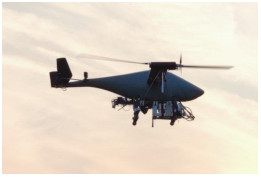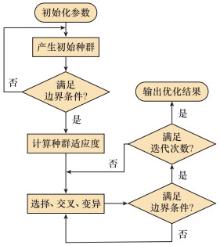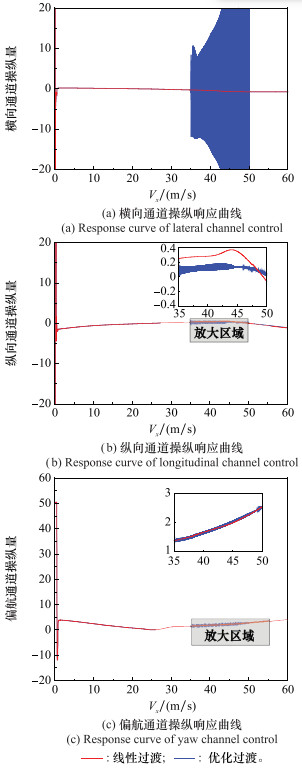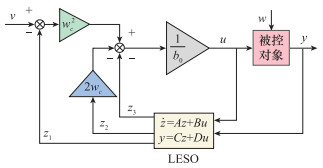Systems Engineering and Electronics ›› 2025, Vol. 47 ›› Issue (2): 608-620.doi: 10.12305/j.issn.1001-506X.2025.02.27
• Guidance, Navigation and Control • Previous Articles
Semi-physical simulation verification of attitude control for compound unmanned helicopter
Bohai DENG, Jinfa XU
- National Key Laboratory of Rotorcraft Aeromechanics, Aviation College, Nanjing University of Aeronautics and Astronautics, Nanjing 210016, China
-
Received:2023-10-30Online:2025-02-25Published:2025-03-18 -
Contact:Jinfa XU
CLC Number:
Cite this article
Bohai DENG, Jinfa XU. Semi-physical simulation verification of attitude control for compound unmanned helicopter[J]. Systems Engineering and Electronics, 2025, 47(2): 608-620.
share this article
| 1 | YAN K , WU Q X . Adaptive tracking flight control for unmanned autonomous helicopter with full state constraints and actuator faults[J]. ISA Transactions, 2022, 128, 32- 46. |
| 2 |
MA H X , CHEN M , FENG G , et al. Disturbance-observer-based adaptive fuzzy tracking control for unmanned autonomous helicopter with flight boundary constraints[J]. IEEE Trans.on Fuzzy Systems, 2023, 31 (1): 184- 198.
doi: 10.1109/TFUZZ.2022.3184386 |
| 3 |
FEMI T , MIJA S J . Output feedback based adaptive composite nonlinear flight control design for a small-scale un-crewed helicopter[J]. ISA Transactions, 2022, 126, 190- 202.
doi: 10.1016/j.isatra.2021.08.004 |
| 4 | CHAUDHARY A , BHUSHAN B . An improved teaching learning based optimization method to enrich the flight control of a helicopter system[J]. Sādhanā, 2022 (48): 222- 237. |
| 5 |
LUCIO R S , JAVIER G , DANIEL C G , et al. Unified motion control for multilift unmanned rotorcraft systems in forward flight[J]. IEEE Trans.on Control Systems Technology, 2023, 31 (4): 1607- 1621.
doi: 10.1109/TCST.2023.3240541 |
| 6 |
SHAO S Y , WANG L W , YAN X H , et al. Trajectory planning and prescribed performance tracking control based on fractional-order observers for unmanned helicopters with unmeasurable states[J]. Aerospace Science and Technology, 2023, 139, 108360.
doi: 10.1016/j.ast.2023.108360 |
| 7 | HYUNCHUL D, HYOUN K, SASTRY S. Control system design for rotorcraft-based unmanned aerial vehicles using time-domain system identification[C]//Proc. of the IEEE International Conference on Control Applications, 2000: 808-813. |
| 8 | MUSIAL M , BRANDENBURG U , HOMMEL G . Cooperative autonomous mission planning and execution for the flying robot MARVIN[J]. Intelligent Autonomous Systems, 2000, 6, 636- 643. |
| 9 |
MUTHUSAMY P K , TRAN V P , GARRATT M , et al. Resi-lient flight control for a 32g Nano helicopter[J]. IEEE Trans.on Industrial Electronics, 2024, 71 (12): 16057- 16067.
doi: 10.1109/TIE.2024.3387096 |
| 10 | DAI J Y, HU F, YING J, et al. Research on attitude control algorithm based on improved linear active disturbance rejection control for unmanned helicopter[C]//Proc. of the Chinese Control and Decision Conference, 2019: 1498-1503. |
| 11 |
QIAO F X , SHI J P , QU X B , et al. Hardware-in-loop adaptive neural control for a tiltable V-tail morphing aircraft[J]. Defence Technology, 2023, 22, 197- 211.
doi: 10.1016/j.dt.2021.12.012 |
| 12 |
SILVA C , RAKOCZY J , GUTIERREZ H . Precision landing comparison between smartphone video guidance sensor and IRlock by hardware-in-the-loop emulation[J]. CEAS Space Journal, 2024, 16, 475- 489.
doi: 10.1007/s12567-023-00518-8 |
| 13 |
SUO B , WANG M N , YUAN F M , et al. Integrity detection and supplementary experimental design of semi-physical simulation data on aircraft landing points[J]. Applied Science, 2023, 13 (5): 2889.
doi: 10.3390/app13052889 |
| 14 |
LIN Z L , WANG W X , LI Y F , et al. Design and experimental study of a novel semi-physical unmanned-aerial-vehicle simulation platform for optical-flow-based navigation[J]. Aerospace, 2023, 10 (2): 183.
doi: 10.3390/aerospace10020183 |
| 15 | XU H Z, HUANG J, ZHOU Y M. Design of multi-mode flight control system for unmanned helicopter[C]//Proc. of the 30th Chinese Control Conference, 2011: 3660-3663. |
| 16 |
GUO J D , LIU Z G , SONG Y G , et al. Research on multi-UAV formation and semi-physical simulation with virtual structure[J]. IEEE Access, 2023, 11, 126027- 126039.
doi: 10.1109/ACCESS.2023.3330149 |
| 17 |
ATHAYDE A , MOUTINHO A , AZINHEIRA J R . Experimental nonlinear and incremental control stabilization of a tail-sitter UAV with hardware-in-the-loop validation[J]. Robotics, 2024, 13 (3): 51- 83.
doi: 10.3390/robotics13030051 |
| 18 |
PARK S H , KWON O J , LEE S . Aerodynamic analysis of high-speed compound unmanned rotorcraft using an unstructured flow solver[J]. International Journal of Aeronautical and Space Sciences, 2023, 24, 1077- 1085.
doi: 10.1007/s42405-023-00595-3 |
| 19 |
ZHAO H B , WANG B , SHEN Y Y , et al. Development of multimode flight transition strategy for tilt-rotor VTOL UAVs[J]. Drones, 2023, 7 (9): 580.
doi: 10.3390/drones7090580 |
| 20 | MOHAMMADREZA M, JUNYI G, AZARAKHSH K, et al. Design, modeling and control for a tilt-rotor VTOL UAV in the presence of actuator failure[C]//Proc. of the IEEE/RSJ International Conference on Intelligent Robots and Systems, 2022: 4310-4317. |
| 21 |
LUO K B , SHI S , PENG C . Smooth tracking control for conversion mode of a tilt-rotor aircraft with switching modeling[J]. Frontiers of Information Technology & Electronic Engineering, 2023, 24, 1591- 1600.
doi: 10.1631/FITEE.2300266 |
| 22 | GU X , XIAN B , WANG Y X , et al. Geometry-based adaptive tracking control for an underactuated small-size unmanned helicopter[J]. IEEE Trans.on Systems, 2023, 53 (12): 7489- 7500. |
| 23 |
HARUNA A , MOHAMED Z , ABDULLAHI A M . Switched step integral backstepping control for nonlinear motion systems with application to a laboratory helicopter[J]. ISA Transactions, 2023, 141, 470- 480.
doi: 10.1016/j.isatra.2023.07.002 |
| 24 | GAONKAR G H, PETERS D A. Review of dynamic inflow modelling for rotorcraft flight dynamics[C]//Proc. of the 27th Structures, Structural Dynamics and Materials Conference, 1986: 89-115. |
| 25 | 陈培, 徐锦法. 四倾转旋翼飞行器直升机模式操纵策略设计与验证[J]. 飞行力学, 2023, 41 (5): 65- 73. |
| CHEN P , XU J F . Design and verification of manipulation strategy for quad tiltrotor aircraft in the helicopter mode[J]. Flight Dynamics, 2023, 41 (5): 65- 73. | |
| 26 |
CARLSON E B , ZHAO Y J . Optimal short takeoff of tilt rotor aircraft in one engine failure[J]. Journal of Aircraft, 2002, 39 (2): 280- 289.
doi: 10.2514/2.2925 |
| 27 |
CASTILLO R S , TOMAS R M . Helicopter nonlinear aerodynamics modelling using VehicleSim[J]. Advances in Engineering Software, 2016, 100, 252- 265.
doi: 10.1016/j.advengsoft.2016.08.001 |
| 28 |
KUMAR A , BENTZVI P . Estimation of wind conditions utilizing RC helicopter dynamics[J]. IEEE/ASME Trans.on Mechatronics, 2019, 24 (5): 2293- 2303.
doi: 10.1109/TMECH.2019.2937844 |
| 29 | 邓柏海, 徐锦法. 复合式无人直升机姿态自抗扰控制[J]. 北京航空航天大学学报, 2023, 49 (11): 3100- 3107. |
| DENG B H , XU J F . Attitude active disturbance rejection control of compound unmanned helicopter[J]. Journal of Beijing University of Aeronautics and Astronautics, 2023, 49 (11): 3100- 3107. | |
| 30 |
LYU Z C , WANG Z G , DUAN D Y , et al. Tilting path optimization of tilt quad rotor in conversion process based on ant colony optimization algorithm[J]. IEEE Access, 2020, 8, 140777- 140791.
doi: 10.1109/ACCESS.2020.3012672 |
| 31 | GAO Z Q. Active disturbance rejection control: a paradigm shift in feedback control system design[C]//Proc. of the American Control Conference, 2006. |
| 32 |
HAN J Q . From PID to active disturbances rejection control[J]. IEEE Trans.on Industrial Electronics, 2009, 56 (3): 900- 906.
doi: 10.1109/TIE.2008.2011621 |
| 33 | 吴超, 王浩文, 张玉文. 基于LADRC的无人直升机轨迹跟踪[J]. 航空学报, 2015, 36 (2): 473- 483. |
| WU C , WANG H W , ZHANG Y W . Trajectory tracking of unmanned helicopter based on LADRC[J]. Acta Aeronautica et Astronautica Sinica, 2015, 36 (2): 473- 483. | |
| 34 |
SHEN S Y , XU J F . Trajectory tracking active disturbance rejection control of the unmanned helicopter and its parameters tuning[J]. IEEE Access, 2021, 9, 56773- 56785.
doi: 10.1109/ACCESS.2021.3071457 |
| [1] | WANG Biao, TANG Chaoying, YAO Zhennan. Trajectory tracking control of unmanned aerial vehicles based oncascaded LADRC design [J]. Systems Engineering and Electronics, 2019, 41(6): 1358-1365. |
| [2] | JIN Jian, CHEN Bohan. Analysis on control strategies of CO2 partial pressure of manned spacecraft assemble with multi-cabins [J]. Systems Engineering and Electronics, 2018, 40(6): 1351-1357. |
| Viewed | ||||||
|
Full text |
|
|||||
|
Abstract |
|
|||||

























